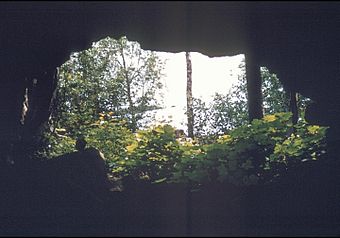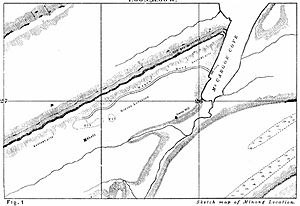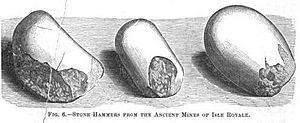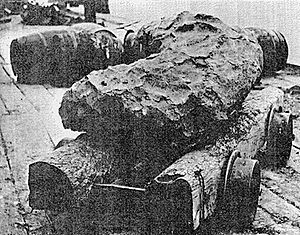Minong Mine Historic District facts for kids
|
Minong Copper Mining Historic District
|
|

Shaft entrance at Minong Mine
|
|
| Location | west of McCargoe Cove campground, Isle Royale National Park, Michigan |
|---|---|
| Area | 275 acres (111 ha) |
| NRHP reference No. | 77000153, 100006259 |
Quick facts for kids Significant dates |
|
| Added to NRHP | November 11, 1977 |
| Designated NHLD | January 13, 2021 |
The Minong Mine is a special historical place found on Isle Royale National Park in Michigan, United States. It's located west of the McCargoe Cove campground. This area holds clues about two different times of copper mining. You can see the remains of a copper mine from the 1800s. It also has signs of even older mining done by Native Americans long before Europeans arrived.
This site was added to the National Register of Historic Places in 1977. Later, in 2021, it was named a National Historic Landmark. This means it's a very important place in American history.
Contents
Ancient Copper Mining: A Look Back in Time
Imagine people mining copper 4,500 years ago! That's how long ago Native Americans first started digging for copper at the Minong Mine site. They used simple tools made of stone to get the pure copper. This copper was found right on the surface or just below it.
They would then hammer the metal while it was cold. This process helped them shape the copper into useful items. They made things like spear points and other tools.
How Ancient Miners Dug for Copper
These early miners dug many pits. Some of these pits were as deep as 30 feet! You can still see these ancient pits at the site today. Some pits even show signs of clever engineering. The miners used large rocks to support the pit walls. They also created drains to remove water from their digging areas.
They had a smart way to break apart rocks called "fire-setting." They would heat rocks with fire until they were very hot. Then, they would quickly pour water on them. This fast cooling made the rocks crack and split. This helped them get to the copper inside.
What We Found from Ancient Times
When people rediscovered these old mines in the 1800s, they were amazed. The ancient digging pits stretched for more than two miles! They were so close together that it was hard to work between them.
Many old mining tools were found at the Minong site. Most of these were smooth, round stones. These stones were used as hammers. People said they collected "cartloads" of them. Other discoveries included a large wooden bowl, a wooden shovel, and a string made from animal hide. These finds help us understand how ancient people lived and worked.
The Minong Mine: Modern Mining (1872-1885)
Modern copper mining on Isle Royale began in the 1840s and 1850s. However, this early mining was not at the Minong Mine site. All mining stopped in 1855. For several years, no one lived permanently on the island.
In 1871, a group of explorers came to the island. They worked for a company called the North American Mineral Land Company. That fall, they found the old Native American pit mines. These pits were located west of McCargoe Cove. In 1872, a new group of prospectors returned. They marked out the area for what would become the Minong Mine.
Starting the Minong Mining Company
In late 1874, the Minong Mining Company was formed in Detroit. Their goal was to mine the copper in this area. The name "Minong" comes from an Ojibwe word. It means "island" in general, and it also referred to Isle Royale.
This company bought land from the North American Mineral Land Company. They started their mining operations in 1875.
Life and Work at the Mine
Most of the copper mining was done in open pits. This means they dug from the surface downwards. But they also dug two deep shafts. One of these shafts went down over 300 feet!
In 1875, more than 50 people worked at the Minong Mine. They lived in a nearby settlement called Cove. This town was at the end of McCargoe Cove. Later, when the mine was busiest, about 150 miners worked there.
A railroad connected the mine to Cove. The mining town had a post office and a dam. It also had a stamp mill, built in 1876. A stamp mill crushes ore to get the metal out. There was also a dock and a blacksmith's shop.
Amazing Copper Finds
The Minong Mine produced some very large pieces of copper. The first big one was found in 1874. It weighed an incredible 5,720 pounds! This huge piece of copper was shown off in Detroit. It was also displayed at the 1876 Centennial Exhibition.
This large copper piece showed signs of being worked by ancient miners. Its surface had bumps and dips. These marks covered every part of the exposed copper. In 1878, an even bigger piece was found, weighing six tons! In 1879, two more large pieces were discovered. They weighed 3,317 and 4,175 pounds.
The Mine's End
In 1879, the Minong Mining Company changed its name. It became the Minong Copper Company. Its main office was still in Detroit. The Minong Copper Company continued mining until June 1883. They stopped operations partly because the price of copper was very low.
A few people kept mining for about two more years. But by 1885, all mining activity had stopped. In the ten years from 1875 to 1885, the Minong Mine produced 249 tons of copper. However, the amount of copper they found slowly decreased. The mine was finally abandoned in 1885.
The Minong Mine Site Today
If you visit the Minong Mine area today, you can still see many things. There are small prehistoric pits. You can also see the larger pits from the 1870s mine. Many of these larger pits are now filled with water. The old mine shafts are also still there.
You might also find piles of tailings. These are leftover rocks from the mining process. The remains of a blacksmith's shop are visible. You can also see old railroad tracks and ore carts. As of 1994, the dam near McCargoe Cove was still standing.
Images for kids









